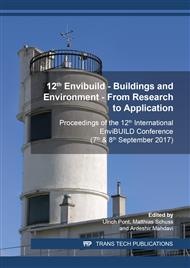p.189
p.196
p.204
p.212
p.219
p.227
p.237
p.247
p.255
Usability and Usefulness of Non-Conventional Building Performance Simulation Tools in Architectural Design Processes
Abstract:
Simulation tools have been suggested to have the potential to support the design of high-performance buildings. However, sophisticated simulation environments are frequently utilized in the later stages of building planning. This might be due, in part, to the lack of sufficient and reliable input data during the early stages of design. Moreover, advanced tools appear to be geared toward consultants and specialists (expert users) rather than primary building designers. In recent years, tools in the CAD and BIM areas have introduced new features for parametric design and interfaces to different calculation and simulation engines. If properly deployed, such tools could offer effective early-design performance evaluation support, for instance via pre-rationalization of building forms and morphologies. Surprisingly, few studies have assessed the usefulness and usability of these new opportunities. In this context, the present contribution documents the background, method, and results of a tool potential assessment study regarding two specific environments, namely Ladybug and Honeybee. These are plugins for the parametrization environment grasshopper. The outcome of this effort provides not only a specific snapshot of the standing of these tools in the context of realistic performance assessment scenarios, but provides also a detailed framework for future critical evaluation of the usability and usefulness of computational solutions for early stage design optimization.
Info:
Periodical:
Pages:
219-226
Citation:
Online since:
January 2019
Authors:
Price:
Сopyright:
© 2019 Trans Tech Publications Ltd. All Rights Reserved
Share:
Citation:


